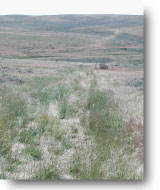 |
|

|
The U.S. Bureau of Land Management (BLM)
manages many outstanding resources, including important wildlife habitat,
scenic western landscapes, flowing streams and rivers, recreational opportunities,
and oil and natural gas production. As oil and gas development and production
continues across much of the rural West, it is important the BLM take
precautions to ensure development on the public lands is conducted in
a manner that prevents or lessens its impact on Public Lands resources. |
|
|
|
|
| Visual Resources The choice
of color is perhaps the most common and simplest BMP for reducing visual
contrast. By selecting colors that help oil and gas equipment blend into
the background, we lessen the visual intrusion on the landscape. |
 Dark green pumping unit partially screened with trees. |
Reducing Human Activity in Wildlife Habitat BMPs can also reduce the footprint of human activity and its harmful effects on wildlife populations. Placing produced oil, water, or condensate tanks in centralized locations, away from important wildlife areas, can greatly reduce the amount of truck traffic in wildlife habitat. Centralizing tank batteries eliminates the need to drive large tanker trucks to each well and reduces the need to maintain large roads in support of the trucks. |
 Centralized tank battery |
When the well no longer produces oil
and gas, final reclamation begins. The well is sealed (plugged) with cement
to protect freshwater aquifers. The entire well location and access road
are reshaped as closely as possible to the original contour, covered with
topsoil, and reseeded. Over a period of years the site will regrow native
vegetation, eventually making it very difficult to find the well location. |
 Interim reclamation on coalbed natural gas access road. |
 |
The continued support and use
of BMPs will help to ensure a sustainable oil and gas exploration, development,
and production program that is conducted in a manner that minimizes harm
to the environment while serving the Nation's energy needs. (At left) A restored well location |
HOME | GENERAL INFO | TECHNICAL INFO | FAQ | LINKS | CONTACTS
|
This page was created by the U.S. Bureau of Land Management, Minerals, Reality, Resource Protection Directorate 1849 C Street N.W Washington, D.C. 20240 Phone: (202) 208-4201 Fax: (202) 208-4201 |
Please contact the NI_Webteam
with |
This is a U.S.
Government Computer System. Before continuing, please read this disclaimer and privacy statement. 
|